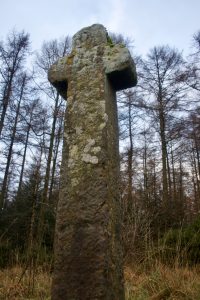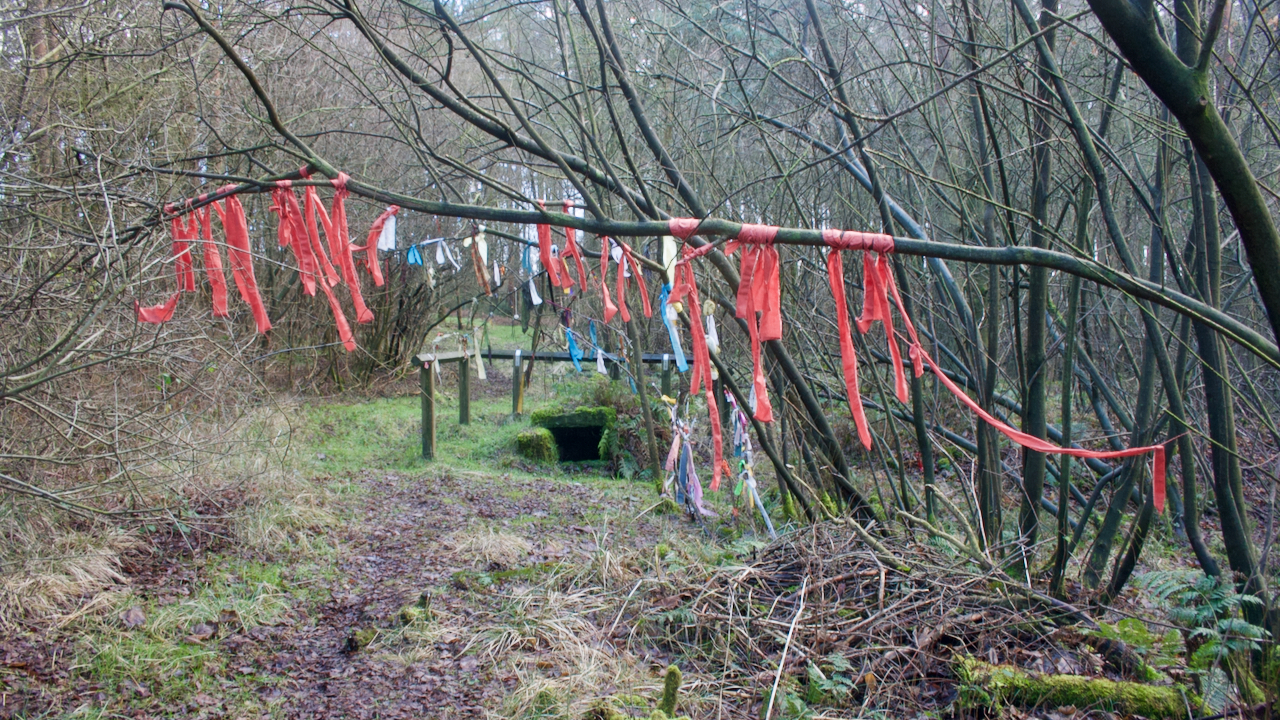A chance to explore the moorland south of Goathland known as Simon Howe Rigg and into the depths of Cropton Forest in search of a moorland cross and a well said to be a holy well.
The two features are just 373 metres apart which may or may not be a coincidence.
Old Wives’ Well, is a spring in a small chamber that is covered by a mound and crudely dressed stone. Apparently on the stone lintol at the entrance to the chamber are the mysterious words “NATTIE FONTEIN“. One suggestion that these could be derived from ‘Fons Natalis‘ who was a Celtic water nymph1F9.co.uk. (2022). Yorkshire Holy Wells. [online] Available at: http://www.halikeld.f9.co.uk/holywells/north/oldwife1.htm [Accessed 16 Jan. 2022]..
The eerie thing about the well though is the perfusion of rags tied to branches. I’m not sure if this is a traditional Yorkshire thing but it is very reminiscent of the ‘clootie wells‘ of Scotland and other Celtic regions of the British Isles. Apparently, a rag, soaked with the ‘holy water’ of the well, is secured nearby and prayers offered to the spirit of the well. The belief is that as the rag disintegrates the prayers are answered2Wikipedia Contributors (2021). Clootie well. [online] Wikipedia. Available at: https://en.wikipedia.org/wiki/Clootie_well [Accessed 16 Jan. 2022]..

Mauley Cross is prominent beside the forest track known as Brown Howe Road which was once a medieval trackway.
Stone crosses are a notable feature of the North York Moors. They were erected at key road junctions, to mark resting places on funeral route, to commemorate a victory in battle, or to mark the site of a murder of sudden death, or just to remind early Christians of their faith.
Although Mauley Cross is thought to be medieval, the site itself could be of ancient significance. In the vicinity a significance quantity of mesolithic flints has been found and what is thought to be a Roman road lies a little to the west.
It is believed that the cross is named after the de Mauley family of Mulgrave Castle, who had a ‘second home’ at St. Julian’s Park, just a few miles north on the ‘Roman’ road3Historicengland.org.uk. (2012). Mauley Cross in Cropton Forest 580m north of Hill Top Farm, Stape – 1011745 | Historic England. [online] Available at: https://historicengland.org.uk/listing/the-list/list-entry/1011745?section=official-listing [Accessed 16 Jan. 2022]..
Some of these de Mauleys were a rum lot. The first Peter de Mauley was one of King John’s henchmen, and reputed to have been involved in the murder, in 1203, of Prince Arthur of Brittany, the King’s nephew and heir. It was as a reward for this deed that the King granted him the hand of the heiress of Mulgrave Castle4Laurence, Alastair. “Old Egton: A New History”. Pages 76/7. Whitby 2018..
And then there was Julian de Mauley who built St. Julian’s Castle. In order to bring ‘good luck’ to his new castle, he walled up a young local virgin named Gyda of Goathland. One year later, her ghost visited de Mauley leading to his paralysis and painful death5Ibid..
So did the de Mauley family raise the cross as redress for their deeds of the ancestors?
- 1F9.co.uk. (2022). Yorkshire Holy Wells. [online] Available at: http://www.halikeld.f9.co.uk/holywells/north/oldwife1.htm [Accessed 16 Jan. 2022].
- 2Wikipedia Contributors (2021). Clootie well. [online] Wikipedia. Available at: https://en.wikipedia.org/wiki/Clootie_well [Accessed 16 Jan. 2022].
- 3Historicengland.org.uk. (2012). Mauley Cross in Cropton Forest 580m north of Hill Top Farm, Stape – 1011745 | Historic England. [online] Available at: https://historicengland.org.uk/listing/the-list/list-entry/1011745?section=official-listing [Accessed 16 Jan. 2022].
- 4Laurence, Alastair. “Old Egton: A New History”. Pages 76/7. Whitby 2018.
- 5Ibid.

Leave a Reply